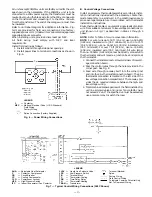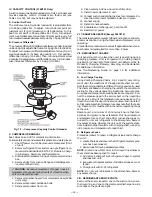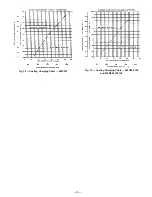
IMPORTANT —READ BEFORE INSTALLING
1. Read and become familiar with these installation
instructions before installing this unit (Fig. 1).
2. Be sure the installation conforms to all applicable local
and national codes.
3. These instructions contain important information for the
proper maintenance and repair of this equipment. Re-
tain these instructions for future use.
CONTENTS
Page
SAFETY CONSIDERATIONS
. . . . . . . . . . . . . . . . . . . . . . . 1
INSTALLATION
. . . . . . . . . . . . . . . . . . . . . . . . . . . . . . . . . 1-9
I. Locate the Unit
. . . . . . . . . . . . . . . . . . . . . . . . . . . . 2
II. Rig and Place Unit
. . . . . . . . . . . . . . . . . . . . . . . . . 2
III. Compressor Mounting
. . . . . . . . . . . . . . . . . . . . . . 2
IV. Unit Refrigerant Piping Connections
. . . . . . . . . . 2
V. Electrical Connections
. . . . . . . . . . . . . . . . . . . . . . 6
VI. Accessory Installation
. . . . . . . . . . . . . . . . . . . . . . 9
PRE-START-UP
. . . . . . . . . . . . . . . . . . . . . . . . . . . . . . . . . . 9
START-UP
. . . . . . . . . . . . . . . . . . . . . . . . . . . . . . . . . . . . . 10
I. Start-Up and Adjustments
. . . . . . . . . . . . . . . . . . 10
CARE AND MAINTENANCE
. . . . . . . . . . . . . . . . . . . . . . 10
SERVICE
. . . . . . . . . . . . . . . . . . . . . . . . . . . . . . . . . . . . . 11-13
I. Cleaning
. . . . . . . . . . . . . . . . . . . . . . . . . . . . . . . . 11
II. Lubrication
. . . . . . . . . . . . . . . . . . . . . . . . . . . . . . 11
III. Condenser-Fan Adjustment
. . . . . . . . . . . . . . . . 11
IV. Capacity Control
. . . . . . . . . . . . . . . . . . . . . . . . . . 12
V. Compressor Removal
. . . . . . . . . . . . . . . . . . . . . 12
VI. Crankcase Heater
. . . . . . . . . . . . . . . . . . . . . . . . . 12
VII. Refrigerant Charge
. . . . . . . . . . . . . . . . . . . . . . . . 12
VIII. Refrigerant Service Ports
. . . . . . . . . . . . . . . . . . . 12
TROUBLESHOOTING GUIDE
. . . . . . . . . . . . . . . . . . . . 14,15
SAFETY CONSIDERATIONS
WARNING:
Improper installation, adjustment, alter-
ation, service, maintenance, or use can cause explo-
sion, fire, electric shock, or other occurrences which may
injure you or damage your property. Consult a quali-
fied installer or service agency for information or assis-
tance. The qualified installer or agency must use only
factory-authorized kits or accessories when repairing this
product.
Recognize safety information. This is the safety-alert sym-
bol. (
) When you see this symbol on the unit and in
instructions or manuals, be alert to the potential for per-
sonal injury.
Understand the signal words — DANGER, WARNING, and
CAUTION. These words are used with the safety-alert sym-
bol. Danger identifies the most serious hazards which will
result in severe personal injury or death. Warning indicates
a condition that could result in personal injury. Caution is
used to identify unsafe practices which would result in minor
personal injury or product and property damage.
WARNING:
Before performing service or mainte-
nance operations on unit, turn off main power switch
to unit. Electrical shock could cause personal injury.
1. The power supply (volts, hertz, and phase) must corre-
spond to that specified on unit rating plate.
2. The electrical supply provided by the utility must be suf-
ficient to handle load imposed by this unit.
3. Refer to the Locate the Unit section on page 2 and
Fig. 2 and 3 for locations of electrical inlets, required
clearances, and weight distribution based on recom-
mended support points before setting unit in place.
4. This installation must conform with local building codes.
Refer to local plumbing or wastewater codes and other
applicable local codes.
INSTALLATION
NOTE:
When installing any accessory item, see the manu-
facturer’s installation instructions packaged with the acces-
sory. A qualified agency must use factory-authorized kits or
accessories when modifying this unit.
The 569C072,090, and 120 units use hermetic compressors.
The 576B090,102, and 120 units use semi-hermetic compres-
sors. Refer to Tables 1A and 1B.
Fig. 1 — Typical Unit (569C072 Shown)
installation, start-up and
service instructions
COMMERCIAL AIR-COOLED
CONDENSING UNITS
569C
576B
Cancels: II 569C-72-3
II 569C-72-4
5/1/99
Summary of Contents for 569C
Page 16: ......
Page 17: ......
Page 18: ...Copyright 1999 Bryant Heating Cooling Systems CATALOG NO 5356 902 ...


































